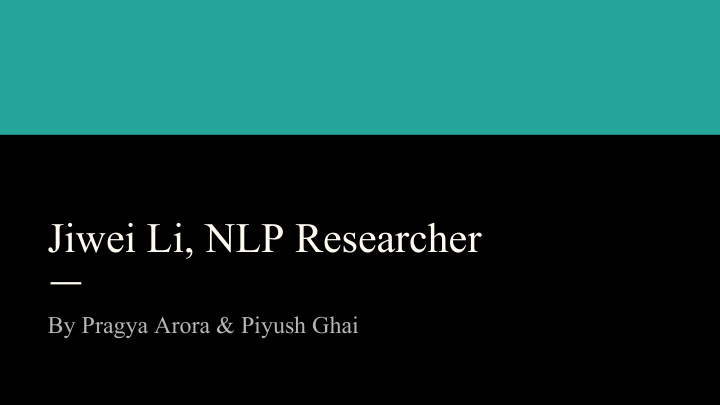



Jiwei Li, NLP Researcher By Pragya Arora & Piyush Ghai
Introduction ● Graduated from Stanford University in 2017 ● Advised by Prof. Dan Jurafsky ● Closely worked with Prof. Eduard Hovy from CMU and Prof. Alan Ritter from OSU ● Affiliated with The Natural Language Processing Group at Stanford University
Research Interests ● Jiwei’s research interests focus on computational semantics, language generation and deep learning. His recent work explores the feasibility of developing a framework and methodology for computing the informational and processing complexity of NLP applications and tasks. ● His PhD thesis was on “ Teaching Machines to Converse ” ● Has over 1200 1 citations on Google Scholar. Has over 38 1 scholarly publications. ● 1 : Google Scholar Site
Teaching Machines to Converse ● Jiwei’s primary research focus and his thesis work was on conversational models for machines. ● Some of his publications in this domain are : ○ Deep Reinforcement learning for dialogue generation [2016], J Li, W Monroe, A Ritter, M Galley, J Dao, D Jurafsky ○ A persona based neural conversation model [2016], J Li, M Galley, C Brockett, GP Spithourakis, J Gao, B Dolan ○ Adverserial Learnig for Neural Dialogue Generation [2017], J Li, W Monroe, T Shi, A Ritter, D Jurafsky
Adverserial Learning for Neural Dialogue Generation
Co-Authors ● Will Monroe, PhD Student @Stanford ● Tianlin Shi, PhD Student @Stanford ● Sebastien Jean, PhD Student @NYU Courant ● Alan Ritter, Assistant Professor, Dept of CSE, Ohio State University ● Dan Jurafsky, Professor, Dept of CSE, Stanford University
Goal “To train and produce sequences that are indistinguishable from human-generated dialogue utterances”.
This paper trended on social media as well...
Adversarial Models It’s a Min-Max game between a Generator & Discriminator
Model Used ● Earlier REINFORCE Algorithm was used, which had it’s own drawbacks. ○ The expectation of reward is approximated by only one sample and reward associate with it is used for all the samples. ● Vanilla REINFORCE will assign the same negative weight for all the tokens - [I, don’t, know], even though [I] matched with the human utterance.
REGS - Reward Generation for Every Step ● They reward the sequence generated at intermediate steps as well. ● They essentially train their discriminator for rewarding partially decoded sequences. ● They also use Teacher Forcing as well, where the human responses are also fed to the generator, with a positive reward. This helps it to overcome the problems where it can get stuck in Minimas and it would not know which update steps to take.
Results
Recommend
More recommend